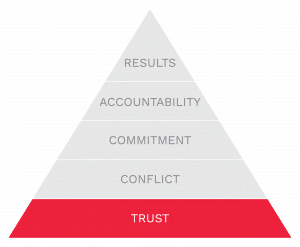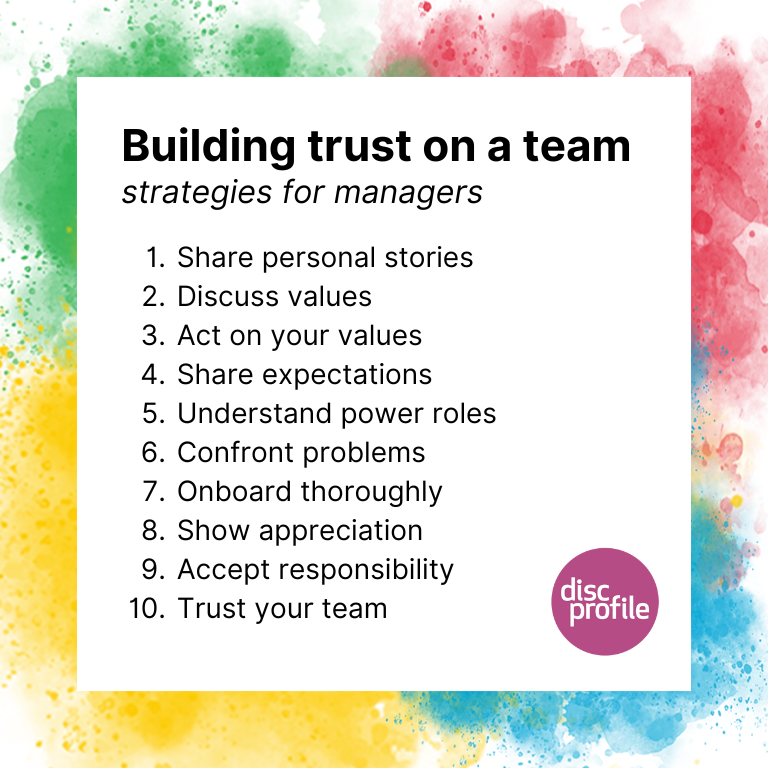Building Trust on a Team: The Manager’s Guide

Key Takeaways
- A team’s manager sets the tone for establishing trust on teams.
- Vulnerability-based trust is the foundation of cohesive teams.
- Managers can take action to build trust on their teams by discussing values, clarifying expectations, understanding power dynamics, and demonstrating their own trust.
Trust is the foundation of the Five Behaviors® model of team-building. That means team success relies on first building trust.

Both managers and individual team members can use the methods below to engage in trust-building.
Great Place To Work Institute
10 strategies for building trust with the team
#1. Share personal stories
There must be a relationship before there can be a trusting relationship.
Stories are enticing ways to share information and create empathy. In The Five Dysfunctions of a Team, Patrick Lencioni suggests sharing personal histories as a way to show vulnerability. Stories make it easy for us to find common experiences and arouse our curiosity about each other. Stories engage us with the storyteller.
Don’t ignore the power of personal connections. These make it easier to ask for and accept help. With personal connections, a team is more likely to initiate hard discussions and to keep energy and enthusiasm high.
Action: Team sharing
Each team member shares a story about their first job, their favorite teacher, a skill, or a life lesson they had to struggle to achieve. The subject should be an experience we’ve all had in one shape or another.
Action: Make space for storytelling
The manager should make opportunities for storytelling and relationship building. These might be over a meal, during meeting breaks, or by establishing a shared working space. If your team is remote, consider a Slack channel for sharing photos from the weekend, movie recommendations, recipes, etc.
Try ending team meetings by having everyone recommend their favorite book or app for their phone. Add personal check-ins along with your project-based ones. Welcome personal stories into your business spaces.
Patrick Lencioni, author of The Five Dysfunctions of a Team
#2. Discuss values
What you value and what the team values will shape its performance. Shared values aid in building trust on a team. It’s easier to engage in conflict if you respect the other person’s values. People who show that they act in ways consistent with their professed values gain in perceived trustworthiness.
Building an environment of trust involves vulnerability and vulnerability can be uncomfortable or scary. Personality assessments can make it easier to discuss issues of trust with your team.
Action: Communicate your values and your team’s
Discuss your values, the values you see expressed by the team, and your organization’s values. A few examples are making a difference, delivering quality, consistently ranking first, meeting deadlines, helping others, showing respect, being accountable, and getting challenging assignments. Schedule times to discuss how the team has been displaying these values and what the group could do better.
#3. Act on your values
People in authority often claim to support values like fair treatment and transparency. However, their actions often tell a different story. Employees will eventually look beyond words to make their judgments.
Good managers establish what Patrick Lencioni calls predictive trust—you’ll do what you say you’ll do. Great managers move beyond predictive trust to vulnerability-based trust. They are open and honest with team members.
Action: Self-reflection
Think about your values: How much are you motivated by a desire for power or influence? What type of leader do you want to be? Are your actions grounded in your values? A 360-degree review can help leaders see their blind spots and show them how their team views their actions.
Trust is built over time and is easy to lose. It takes consistent work and it pays off with teams that are committed to each other and energized by their work together.
Brené Brown, author of Dare to Lead
#4. Share expectations
Your shared values will shape your expectations. If everyone can agree to the norms, then everyone knows whether they or others are complying. A shared understanding of expectations provides a foundation for building trust on teams.
Action: Define team norms
Each member speaks briefly about behaviors they feel contribute to group health and those that don’t. Work together to define your team norms and ground rules. Be sure to cover issues such as uses of technology, means of communication, and methods of addressing problems. Some discussion questions:
- How will we communicate questions about the project?
- How will we communicate if there’s a crisis?
- Do people agree to ask for help and admit mistakes?
- How will we alert others if we can’t complete a task or there is a delay?
- Are people comfortable celebrating after work hours?
- Is it OK to brag or show excitement about something we’ve just accomplished?
- How will we address time zone differences?
- How will we hold each other accountable?
- How will we offer feedback to each other?

#5. Understand power roles and where you fit in
University of Cologne psychologist Joris Lammers has shown that a person’s honesty depends on that person’s feeling of power. Higher feelings of power correlate with less concern about the long-term consequences of being untrustworthy. We’ve probably all intuited these findings and feel at least a slight distrust of authority.
Team members should know where the final authority lies. If this is clear, they can avoid conflicts and confusion over approvals. Leaders can make it easier to trust them by helping the team understand their leadership role on the team.
Action: Discuss power roles
Discuss how power is given and used by members of the group. What are the power dynamics (perceived and real) in this team? How will you as a manager demonstrate you are worthy of trust in your position of power? Provide your team clarity on issues like:
- Is leadership fluid throughout the project, based on who is most knowledgeable about each step?
- Is there an outside sponsor of your team who has ultimate responsibility and authority?
- Is leadership part of the team or outside the team?
- When, where, and how will the leader be involved?
#6. Confront problems
Nothing builds trust in the workplace like using teamwork to overcome an obstacle. A team is more likely to meet a challenge if they feel comfortable confronting conflict and holding each other accountable.
Many people are familiar with the phases of teams as forming, storming, and norming. You have to find ways to make use of the storming periods.
Action: Start a team dialogue about conflict
Answer these questions.
- Where does our team fall on the conflict continuum?
- How have we confronted internal and external challenges in the past? What worked and what did not?
- How will we recognize and acknowledge both productive and disruptive behaviors on the team?
#7. Make thoughtful onboarding a priority
Onboard new team members by reviewing the “rules of engagement” the team has agreed upon. Even better, renegotiate them in light of new members.
Onboard quickly and thoroughly. We’re more likely to give someone the benefit of the doubt when we first meet them. So make use of this initial goodwill and build upon it. Provide time for sharing stories among the team and exploring the team’s history and culture.
Action: Make sure the new hire and team know their roles
Managers should ensure that all team members understand the team goals and how each of them can use their unique skills to contribute. A recent survey by Wiley Workplace Research found that only 38 percent of recently hired workers finished their onboarding experience with an understanding of what was expected of them. The job description you provide to the new hire should align with the job description in team members’ minds.
Managers should know what HR offered the new hire and how they explained the job. Without knowing how their performance will be judged, new team members are more likely to see others as judges rather than collaborators, and trust will take longer to build.
#8. Show appreciation
We all feel good when our contributions, perspectives, or personalities are appreciated. Expressing appreciation is also beneficial for the giver. Research shows that expressing gratitude builds trust and closer bonds between the giver and receiver of thanks, and the people who witness the act of gratitude.
If a manager trusts their team, they’ll back them up on their journey and take pride in their successes. They’ll acknowledge individual efforts and the team. Show your team that you don’t take them for granted and that you won’t take all the credit for team results.
Take care in how you notice and assign credit for work. Often, whoever speaks most confidently, loudly, or persistently about an idea or result gets more credit for it. This tendency can overlook introverts, women, and people from less individualist cultures—even when they’re the ones who contributed most to the project’s success. Managers who consistently reward the wrong person can reduce the amount of trust on the team.
Action: Make a plan for regular appreciation
Write appreciation into your workplan. It can be as simple as showing interest in someone’s ideas. Some teams regularly go around the table and state one thing they appreciate about each team member. Others have a Slack channel devoted to praising each other.
Robert Townsend, former CEO of Avis
#9. Accept responsibility for errors and admit mistakes
If your team is hiding mistakes or weaknesses from each other and from you, you know you have a trust problem. You also likely have a performance problem, as these cover-ups often lead to stalled-out projects or redoing work.
Managers demonstrate they are worthy of trust when they follow a fair process and hear from all sides. They admit that they don’t have the facts, experience, and knowledge that the entire team has. A leader with vulnerabilities is stronger than one who insists on having none.
Action: Make it OK for people to admit mistakes
Set a team norm that accepts acknowledgment of failures or limitations and makes it OK to ask for assistance. Model this by admitting your own mistakes and by apologizing or fixing the issue. Discuss with your team about how you all will create a space of psychological safety where people can admit mistakes.

#10. Trust your team
It’s hard to gain the trust of your employees if they can tell that you don’t trust them. Managers are responsible for their teams. If the team fails, so will they. This can trigger a desire to micromanage to ensure success, but micromanagement is a strong signal of distrust.
Managers should check in with employees rather than check up on them. They should provide information, guidance, feedback, mentorship, support, and necessary resources. The leader models how to ask for and respond to feedback.
Do you trust your team? If not, why not, and what can you do about it? If you do trust them, make your expectations clear and then step back and allow team members to take their own paths. Allow them to learn from failures.
Action: Demonstrate trust
Managers can demonstrate trust in their team in many ways:
- Delegating responsibility
- Encouraging employees to share honest thoughts
- Providing opportunities for growth
- Allowing flexible work arrangements
- Involving your team in decision-making
- Encouraging calculated risk-taking
- Providing resources rather than hoarding them
Mike Krzyzewski, former college basketball coach

Building trust on teams begins with managers and leaders
Research by Jon Maner, a professor of management and organizations at Kellogg School of Management, asserts that some leaders “will intentionally sideline high-performing team members, limit communication and social bonding among team members, or compile ill-matched teams if they think it will help ensure their own place at the top.”
The manager of a team and the leader of the entire organization set the tone for a group’s culture and level of trust. A leader who doesn’t trust their team can discourage trust among the team members, too. Poor leadership habits, fears, and personal ambition can plant the seeds of distrust in groups.
Bill George, Discover Your True North
Invest in self-awareness
Employees are more likely to trust managers who are self-aware. Managers need to understand their tendencies around communication, conflict, decision-making, and other management tasks. They need a realistic view of their strengths and weaknesses, and a plan for developing their soft skills. Consider personality tests, 360 assessments, coaching, and other tools.
As a manager, you can model self-reflection and continuous improvement to your employees. This sets a positive example for the team and encourages a culture of learning and growth.
As you work to deepen your self-awareness, consider discussing with your team what you are learning. For example: “I'm aware that I'm naturally conflict-averse. Because of this, I've shut down some heated debates in the past that could have been productive for our team. Gaining comfort with productive conflict is one of the skills I’m developing this year.”
Leaders and managers are often unaware of how they influence team culture by modeling appropriate or inappropriate behaviors. If you are a manager or leader, read through the suggestions in this article and assess yourself honestly. If you are a coach working with leaders, explore these topics with your clients.
Use an assessment like Everything DiSC® Management to uncover your natural preferences and priorities as a manager. You’ll learn how to create more effective strategies for directing your employees. Or try the Everything DiSC Work of Leaders® profile to discover your leadership style and priorities.
The Five Behaviors model is a proven tool for building trust on teams.
Managers who present themselves authentically—and who prove that they are worthy of trust—have taken a long stride in their journey toward building trust on their team.
Posted 01/29/2024







